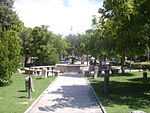Saturnia
| Saturnia | |
|---|---|
| Frazione | |
 | |
 Saturnia | |
| Coordinates: 42°39′59″N 11°30′15″E / 42.66639°N 11.50417°ECoordinates: 42°39′59″N 11°30′15″E / 42.66639°N 11.50417°E | |
| Country |
|
| Region |
|
| Province | Grosseto (GR) |
| Comune | Manciano |
| Elevation | 294 m (965 ft) |
| Population (2010) | |
| • Total | 280 |
| Demonym | |
| Time zone | CET (UTC+1) |
| • Summer (DST) | CEST (UTC+2) |
| Postal code | 58050 |
| Dialing code | 0564 |
Saturnia is a spa town in Tuscany in north-central Italy that has been inhabited since ancient times. It is a frazione of the comune of Manciano, in the province of Grosseto. Famous for the homonym spa, its population is of 280.[1]
Geography
It lies about 23 miles northeast of Orbetello and the coast. Near the village, 800 litres per second of sulphurous water at 37 °C gushes into a large natural pool, flowing over a waterfall and down to a series of natural pools carved in the rock.
History

Saturnia takes its name from the Roman god Saturn (us). Legend has it that he grew tired of the constant wars of humans, and sent a thunderbolt to earth that created a magic spring of warm sulphurous water which would pacify mankind.
Dionysius of Halicarnassus lists Saturnia as one of the towns first occupied by the Pelasgi and then by the Etruscan civilization. A Roman colony arrived in 183 BC, but little is known about it other than the fact that it was a prefecture. There are still remains of the city walls, in the polygonal style, which contain Roman gateways. Roman remains have also been discovered within the town, and remains of tombs outside. These tombs were originally covered by tumuli, which have now disappeared, so that George Dennis, author of Cities and Cemeteries of Etruria, mistook them for megalithic remains.
In 1300, Saturnia became the hideout of outlaws and was razed to the ground by the Sienese. Forgotten for several centuries, Saturnia was rediscovered in the late 19th century when the land around the spring was drained and a spa built. Thousands of visitors come to bathe in the waters to this day.
Main sights
Church of Santa Maria Maddalena

The Church of Santa Maria Maddalena is the main church in Saturnia. The earliest historical records related to the church date back to 1188, but the building is due to a restoration of 1933.
The church holds the famous Madonna and Child frescoe attributed to Benvenuto di Giovanni at the end of the 15th century.
Terme di Saturnia
Other sights
- Rocca Aldobrandesca
- Saturnia Walls (Mura di Saturnia)
- Roman Gate (Porta Romana)
- Archaeological museum
Gallery
-

Saturnia hot stream
-
Village square
-

Roman gate on the Via Clodia
-

Gorello waterfall
See also
- Pitigliano, some 12 miles to the southwest, is another Etruscan site
- Similar places
- Geothermal areas of Yellowstone in the USA
- Pamukkale in Turkey
- Badab-e Surt in Iran[2]
- Pink and White Terraces in New Zealand were similar travertine terraces until they were covered in a volcanic eruption
References
- ↑ (Italian) Infos on italia.indettaglio.it
- ↑ Badab-e Surt on WikiMapia
 This article incorporates text from a publication now in the public domain: Chisholm, Hugh, ed. (1911). Encyclopædia Britannica (11th ed.). Cambridge University Press
This article incorporates text from a publication now in the public domain: Chisholm, Hugh, ed. (1911). Encyclopædia Britannica (11th ed.). Cambridge University Press
External links
| Wikimedia Commons has media related to Saturnia. |
